
By Vidhaan Sehgal, Fitness Expert, Marathon Runner & Writer at Articoli News, 09.11.2025. Writing about carbon-plated running shoes, to Indian runners, to make informed performance decisions.
🏁 Introduction: The Future of Running Performance
The fastest marathon times in history wouldn’t exist without carbon-plated running shoes. They’ve changed the way athletes train, race, and even recover. Yet, most runners still wonder: How do these shoes actually work, and should I buy them?
As a fitness expert and running athlete from Delhi, I’ve trained with traditional trainers and now use carbon shoes for racing. This guide explains what makes these shoes powerful, the science behind them, and who should really invest in a pair.
📘 Table of Contents
- The Hook and Performance Promise
- The Science Explained
- The Carbon Shoe Controversy
- Who Needs a Super Shoe?
- Practical Usage: When to Wear Them
- Conclusion & Final Thoughts
- FAQs
1. The carbon-plated running shoes and Performance Promise
The carbon-plated running shoes have redefined modern running. You’ll see them on elite athletes and amateur racers chasing personal bests. But what really makes them fast?
This blog breaks down the two main performance elements, the carbon plate and hyper-foam technology, and clears up myths about speed, injury, and value. By the end, you’ll know if you’re ready to run in super shoes.
2. The Physics of Speed: How the Plate and Foam Work:
The Carbon Plate (The Lever)
The carbon plate inside carbon-plated running shoes acts like a lever, not a spring. It reduces how much your foot bends while running. This helps conserve energy that would otherwise be lost in stabilizing the ankle and toes. Think of it like running on a firm board instead of soft sand—your energy goes forward, not down.
The Hyper-Foam (The Spring)
The true “bounce” of carbon-plated running shoes comes from lightweight midsole foam—usually PEBA or PebaX. This foam compresses and expands quickly, returning more energy every step. The carbon plate helps stabilize this foam, preventing it from feeling too soft.
The Combined Effect
Together, the foam and plate work like a perfect team. The foam provides energy return, while the plate channels that energy forward—helping runners push off the ground faster and more efficiently.
3. Myth vs. Reality: The Biggest Concerns About Super Shoes
Despite their success, carbon-plated running shoes are surrounded by myths and confusion.
Myth #1: They Make Everyone Faster
Reality: These shoes show real benefits only at faster paces (below 5 min/km). For slower or casual runs, they may even feel uncomfortable.
Myth #2: They Cause Injury
Reality: The plate changes running mechanics, putting more load on calves and Achilles tendons. Beginners should build lower-leg strength before switching. Always transition slowly to avoid injuries.
4. Who Should Buy Carbon-Plated Running Shoes?
Here’s a quick guide to help you decide:
| Runner Profile | Should You Buy? | Why |
|---|---|---|
| Newbie/Casual Runner | ❌ No | Focus on form and strength before upgrading. |
| Intermediate Runner (Training for PB) | ⚖️ Maybe | Great if you run 3+ times/week and aim for race improvements. |
| Competitive Runner | ✅ Yes | A must-have for peak performance and marathon racing. |
5. The Practical Guide: When to Race Them And When to Rest Them
Carbon-plated shoes are race-day tools, not daily trainers.
When to Wear:
- During races (5K, 10K, Half Marathon, or Marathon)
- For speed sessions like tempo or interval workouts
When NOT to Wear:
- Easy recovery runs
- Long-slow-distance runs
Using them only for key workouts conserves their short lifespan (usually 150–250 miles). Treat them like a sports car—fast, expensive, and not for daily driving.
Here are some of my personal recommendations for carbon-plated shoes : Nike Alphafly 3, Adidas Adios Pro 3, Asics Metaspeed Sky+, and Puma Fast-R Nitro Elite
(You may also choose some of your favourite brands or series, as per your requirements. )
6. Conclusion & Final Thoughts
Carbon-plated running shoes are revolutionary, but they don’t replace consistent training, proper nutrition, and recovery. They’re a performance tool, not a magic fix.
As an athlete, I recommend runners test their speed in regular shoes first, then try a carbon pair before an upcoming race. Feel the difference, but remember: shoes enhance performance; they don’t create it.
“Technology helps, but discipline wins races.” – Vidhaan Sehgal
Your Turn: If you’ve tried carbon-plated shoes, “Which shoe did you buy, and what was the specific moment you felt the difference during a race? Share your experience in the comments below.
FAQs
Q1: Are carbon-plated running shoes good for beginners?
A: Not really. Beginners should build a strong base and running form before switching to high-performance shoes.
Q2: How long do carbon-plated running shoes last?
A: Typically between 150 and 250 miles. They’re built for performance, not durability.
Q3: Can I wear carbon-plated running shoes every day?
A: No. They’re designed for race days and speed workouts only.
Q4: Do carbon-plated running shoes really make you faster?
A: Yes, but only when used at faster paces and with proper technique. Studies show up to 4% energy savings.
Q5: What are the best carbon-plated running shoes in India for 2025?
A: Nike Alphafly 3, Adidas Adios Pro 3, Asics Metaspeed Sky+, and Puma Fast-R Nitro Elite are leading models available in India.
Blog written by, Vidhaan Sehgal, a professional fitness coach and running athlete, Delhi, India, 09.11.2025
Articoli’s take: For better health & high performance, you must visit this article by an expert :🌙Natural Sleep Remedies: 5 Ways to Ignore Melatonin and Sleep Better Tonight
